| The subject of this article is from the Desolation update.
The information from this article is up-to-date as of 22 September, 2020. |
The information from this article is up-to-date as of 22 September, 2020.
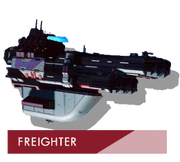
Freighter Types is a starship details page.
Summary
Freighter Types describes the various classes of Freighter starships. Note that these names are commonly used by the No Man's Sky community, and are not official descriptions from the game itself.
- For a description of Freighters in general, refer to the Freighter page.
- For a list of discovered freighters, refer to the Starship Catalogue - Freighter page.
Capital
All capital freighters follow one of two unique designs and are very much able to defend themselves, unlike the regular freighters. They are encountered during space battles, in which a player is asked to help them for a chance to purchase them later on.
Inside a design, the classes can vary in visual size, which most likely is a remnant of Hello Games initial inventory system of small, medium and large. However, all visual sizes can have 34 slots since Atlas Rises and a player can therefore opt to 'grind' their most beloved design choice.
Venator Family
All ships in Venator family share the same base design, and differ by the number of midsection indentations:
- Venator-class: 2 indentations
- Imperial-class: 4 indentations
- Resurgent-class: 6 indentations
Venator-class
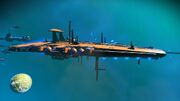
Venator-Design (small)
This unique design seems to be a nod to the Venator Star Destroyer of the Star Wars Universe. Unlike the elongated medium and large version of this design, the small version has a striking resemblence to its original inspiration, down to the non triangular shape of its nose. Venator Star Destroyer
The Venator-Design has a basic defense of two turrets on its upper left and right per mid-section. Added to this are one slightly displaced turret on the forward midsection and another turret on the upper tip of the bow. The lower bow comes with two forward turrets, left and right respectively. Like the Sentinel-Design, the bow has 4 turrets in total and each midsection has 2. For each elongation of the Venator-Design another turret gets added below for their suborbital defense with even more extra being added alongside a military keel AND a cargo unit each. This can result in a Resurgent-class fielding up to 20 turrets, more than any freighter in the universe. Due to the inconsistent placement of the turrets, it is near impossible to line more than a handful of turrets to prevent them from firing, making the Venator-Design the one with fewer flaws in its defense. Attack from the lower back to minimize hostile fire!
Imperial-class
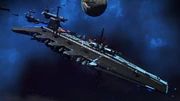
Imperial-class
Less distinct than the Venator-class, the Imperial-class Star Destroyer still resembles its likely inspiration more than its namesake. However, it has a longer midsection and 4 indentations, which effectively doubles its size.
Resurgent-class
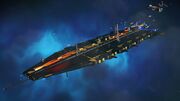
Resurgent-class
The Resurgent-class Star Destroyer is the biggest known variant of the Venator-Design Star Destroyers. They all have a huge midsection and 6 indentations, instead of 4 or 2. Most freighters look like dwarves near this beast.
Don't ever make the mistake, these ships are no basic freighters and are no quick haul! Like its pendant, the Resurgent battleship is a terrifying foe in battle. While it disregards most of its lower plane defense, its frontside and broadside potential is outright insane.
The entrance to the hangars is protected by 6 turrets aligned in three rows on both sides. Meanwhile the frontside has another 6 turrets with an extra bow turret on the tip and a middle turret on the first row, giving it 8 turrets for forward and 6 for aft (rear) defense. Below the Resurgent, it foregoes defense of the back with only one turret and doubles down on the front with two, as well as possessing three centrally mounted turrets, two in front of the under hull cargo pods and one in between them. Thus the ship comes down to a total of 20 turrets if it comes equipped with a military keel. Roughly 15 are able to shoot at mid and far broadside distance at targets at all times. The number fluctuates due to the obstructing elements on the ships top and bottom. Not all turrets are mounted above or below the ships actual plane of sight.
A Resurgent battleship can dominate any non-close encounter with its broadsides. Fighter squadrons are advised to attack from below and behind.
Sentinel Family
All ships in Sentinel family share the same base design, and differ by the number of midsection segments with cargo pods attached:
- Sentinel-class: 3 midsection segments
- Tier 2: 1 extra add-on with additional cargo pods underneath the hull
- Tier 1: no additional cargo pods
- Battleship-class: 5 midsection segments
- Tier 2: 1 extra add-on with additional cargo pods underneath the hull
- Tier 1: no additional cargo pods
- Dreadnought-class: 7 midsection segments
- Tier 3: 2 extra add-ons with additional cargo pods underneath the hull
- Tier 2: 1 extra add-on with additional cargo pods underneath the hull
- Tier 1: no additional cargo pods
Sentinel-class
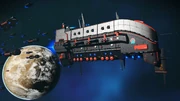
Sentinel-class
Unlike the Star Destroyers, the Sentinel-Design is reminiscent of the gothic sci-fi design of Warhammer 40k. In particular it is a mix of the Ark Mechanicus' bow and superstructures and the general shape of the Vengeful Spirit. No matter its inspiration, it offers players a clear choice for their capital ship with a hugely different design.
This design is also the official carrier of the sentinel armada in No Man's Sky. However, other races are using them as well and offer the player to purchase them after a successful battle. This suggests that all Sentinel-class capital ships were made by the Sentinels and were either disabled, captured, salvaged, and/or repurposed by the other Races. The smallest visual version has three midsections, but can also show with two pairs of additional cargo pods.
Sentinel-class capital ships have a pair of turrets on either side of the bow, one mounted on top of the bows midsection and another on its lower fang. Further turrets are mounted on either side of each mid-section in its respective centre. This position is elevated and allows to fire in an angle to reach the upper and lower planes partially. Each turret rotates and can fire from long range, making them a challenging fight. Because of the rather thin shape of the ship and the turrets great positions, the only viable angle of attack is from behind. Often these ships come with some protrusion in between the turrets. If lined from behind the ship can be attacked and disarmed without facing the bow turrets. Even without the protrusions, an attacker can line up the turrets to block each other. A chance to install them with a slight variation in position was missed, turning the turrets themselves into obstacles. It is possible to make a backstrike to gain safe access to some of the cargo units below any Sentinel-Design ship this way. This fatal design flaw of lining all turrets makes it actually weaker than the Star Destroyers if abused properly.
Battleship-class
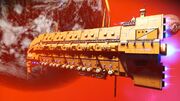
Battleship-class
The Battleship-class is the medium version of the Sentinel-Design and sports 5 instead of 3 segments in its midsection, but can also show with 2 pairs of additional cargo pods.
Dreadnought-class
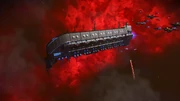
Drednought-class
The Dreadnought-class describes the biggest version of a Sentinel-Design capital freighter. It has 7 segments for its midsection and also can come with 2 or 4 pairs of additional cargo pods. It dwarfs most other freighters in direct comparison. The sentinel mothership is a seven-segment carrier as well. (the ship has a total of 20 turrets).
Regular
Unlike the capital freighters, regular freighters don't have static designs. They are assembled from a random combination of stern, midsection, bow and keel, all of which are independent of race. While their most distinct part is the bow, there are also some versions that seem to only consist of a stern and midsections of varying size with no bow or keel at all. While all bows retain the standard front side turret or add a second one, only the huge defensive platform below serves as a military module for the keel and is thus part of a proper military freighter. The military keel turns blind-sided freighters like the Enterprise-class or the Cargo-class into more dangerous foes as it removes its weakness. Others like the Hammerhead-class gain a huge 3-turret alpha strike angle.
Basic Threat Level (no keel):
- Hammerhead-class
- Revolver-class
- Galleon-class
- Blade-class
- Enterprise-class
- Cargo-class (Cuboid)
- Cargo-class (Underbite)
- Iris-class
- Oculus-class
- Cargo-class (Overbite)
- Centrifuge-class
Note: With a military keel the Enterprise-class easily outcompetes the Blade-class and Galleon-class. Its only weakness is the lack of a lower plane defense without.
Blade-class
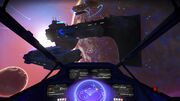
Blade-class Freighter
The Blade-class freighter appears to be one of the standard models, due to its frequency. Its main feature is the giant bow in the shape of a tapered blade, which normally takes up more than its height. In general the blade is affixed to the right side of a freighter.
The blade has a turret affixed to its right side. Together with the top gun, this covers its entire top and right flank. This however still leaves the forward area of its lower left undefended, leading to a 270° coverage. The military capacity of the Blade-class lies solely in convoys with several ships shielding each others left in diametrical formation of a cube. It trades coverage for firepower.
Cargo-class
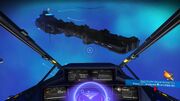
Overbite Cargo-class Freighter
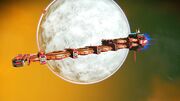
Underbite Cargo-class Freighter
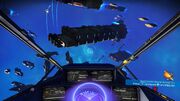
Cuboid Cargo-class Freighter
A Cargo-class freighter marks the most basic design a regular freighter can have. It has no bow and simply consists of a rear and midsection with a varying bridge design. This class can be further differentiated by the shape of its midsection showing an Underbite design or an Overbite design. If both roughly align it is a Cuboid design. Even though the different cargo section designs are most prominent here, the difference between the spherical and cuboid containers is only cosmetic from a gameplay sense and does not affect the goods that they can carry.
Contrary to expectation, the Cargo-class can be heavily defended. A missing bow doesn't shield the cargo or frontal area from direct attacks, but in return offers free aim. The deadly variants are the Underbite and the Cuboid as those have one turret at the end of each of their cargo rows. For a Cuboid cargo freighter this means concentrated firepower along its topside and for an Underbite freighter this means forward defense and defense of the bridge respectively for the topside. These heavily defended cargo freighters might better be avoided by pirates in favor of the weakly defended Overbite freighter, which only has one topside turret.
Centrifuge-class
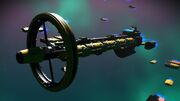
Centrifuge-class Freighter
A Centrifuge-class freighter is classified by its more realistic design for the bow. Unlike other freighters, this class has a habitable module in front of its cargo unit. Due to its constant rotation, artificial gravity is produced and supports an environment for plants to grow upwards and for humans to live without atrophy. This design is also similar to the Crashed Freighters seen on most planets.
Unlike other civil freighters this design is completely defenseless. The only way a turret can be mounted is on Centrifuge-class freighters with a military keel. This weakness is a plausible explanation for why they make up such a large share of crashed freighters.
Enterprise-class
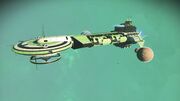
Enterprise-class Freighter
The design of the Enterprise-class bears striking similarity to the saucer section of some ships in the Star Trek universe. Its bow is a plate with two turrets on its upper plane on the left and right and could thus also be referred to as a Disc-class ship. These turrets are separated by a protruding bridge, a concept not seen in early and Galaxy-Class Star Trek Federation ships. However, this protruding bridge is seen in the Intrepid-class of Voyager and the Sovereign Class of The Next Generation.
Due to the obstruction in sight, the two turrets lose most of their alpha strike potential on a neutral plane during a left or right attack. They still retain their ability to combine their attack for any other vector from the front, back or upper plane. Yet, the real flaw of the Enterprise-class lies below. Without a military keel it is downright defenseless without an escort fleet. This flaw makes it one of the weaker military freighters without a keel to protect it. Attacks from below on non-militarized freighters are more than encouraged. However, if an Enterprise-class ship has a military keel it has no weakspot and a decent broadside capability on mid and far range to the left and the right. It is no match for a Hammerhead-class though.
Galleon-class
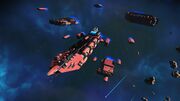
Galleon-class Freighter
As one of the more dangerous freighters, the Galleon-class unites beauty and firepower in one vessel. The entire design leans heavily on seafaring ships and copies the general shape down to a symbolic front mast. Its symbolic galleon figure is another deadly turret with a huge aiming angle along the bow's shape. This turret is accompanied by a topside turret in the centre of the bow.
Among the four military freighters the Galleon-class is the only one to abandon its rear defense and instead focuses all might of its alpha strike on a frontal assault. This not only allows it a smaller profile during frontside engagements, it also offers the chance to cover the entire ship in basic air defense with a military keel. A military keel Galleon-class freighter has a near 360° coverage in all directions. Even without the keel it still has a solid 300° grid. However its alpha strike grid is a meager 90° in close combat up to around 200° in far distance combat. A fully equipped war galleon (3 turrets) would only have alpha strike potential on far distance targets and only for 90°, with 45° each to the frontside from its left and right.
Hammerhead-class
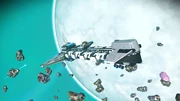
Hammerhead-class Freighter
Unlike most other freighters, the Hammerhead-class can be seen as a military vessel. It also is one of the most common freighters in the game. The name stems from the thick head that has two thinner fins parietal to its bow.
If accompanied by a proper defense platform for its keel to support its lower plane defense, it is one of the most dangerous ships to be attacked. Its complementary variant is the Revolver-class. The hammerhead not only serves as a massive defensive and well armored structure to defend the cargo units behind it, it also boasts two elevated turrets, one on the upper and one on the lower side of the bow. This not only allows for 180° of coverage for the top and down plane, but also allows both to concentrate fire alongside the hammerhead fin diagonals. The Hammerhead-class excels in broadside and high range frontside battle. With a military keel it also dominates the lower plane battlefield. It is advised to attack a Hammerhead-class from the top.
Iris-class
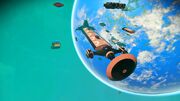
Iris-class Freighter
An Iris-class freighter is a variation of the Oculus-class. Seen and documented for the Delta and Gamma Quadrant after its sister class, this special version of the largest freighter shares all its major features down to the detachable unit with turrets on the top- and downside of the cross section. Instead of a full-blown sphere, this version only has a disc-shaped and rotating aft. The name stems from the design as a small pupil is surrounded by a major dark region symbolizing an iris and finally surrounded by a brighter outer layer for the symbolic eyeball. Unlike the Oculus-class, this version of the stern has neither the space nor the solar cells to be fully viable as a spaceship on its own.
Oculus-class
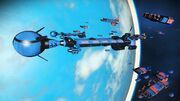
Oculus-class Freighter
The Oculus-class is the biggest known regular freighter and likely a tribute to the ship Discovery One from 2001: A Space Odyssey. The Oculus' bow has an extra engine unit and huge space for internals in its sphere. In theory it could function like a detachable module for an independent spaceship. Gameplay-wise, however, it does not offer more space than other regular freighters. To enhance the detachable unit's self-sufficient capabilities, it's also equipped with four solar energy modules around the oculus and a turret on the top and bottom of the connector section respectively. It was most commonly seen in the Alpha Quadrant.
Revolver-class
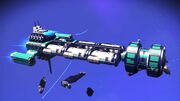
Revolver-class Freighter
The main feature of the Revolver-class is the cylinder-shaped bow with an indentation between its two main rings. It fields two gun turrets on the sides of the frontal ring. Even though its inner mechanics are shown at the front as two diametrically running gears, the outer hull can and does not turn. This weakens its military potential by leaving the turrets' positions fixed rather than them being able to rotate with that platform.
Where Hammerhead-class specializes in broadside engagements, the Revolver-class excels in vertical combat with both turrets affixed to the bow's side. While the bow lacks the small profile of the hammerhead and thus obscures concentrated fire near the freighter itself, mid to far range engagements allow a concentrated attack. Meanwhile the bow also allows flexibility for frontside engagements. Unlike the Hammerhead-class these frontside alpha engagements are not limited to far distances due to the guns position at the front of the revolver. However, the hammerhead protects their guns with a backrow position from most direct fire with its profile. Here they are more prone to being hit and consequently destroyed as they are fully out in the open.
Combined with a military keel, the plane below a Revolver-class freighter can turn into a killing field of three gun turrets. Its weakness are pirates and pilots that close the distance to the bow and attack from its own deadzone. This can be achieved from the left or right, especially without a military keel defending either vector. Regardless of the keel, a top left or top right approach is always advised.













